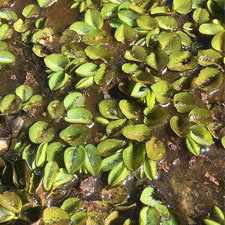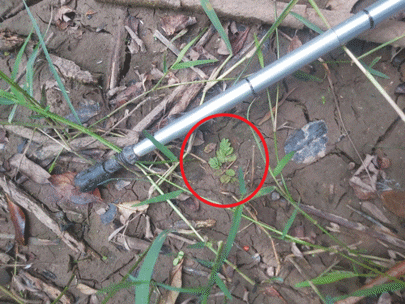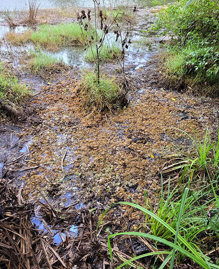 Salvinia
Salvinia
Common name: Salvinia
Botanical name: Salvinia molesta
Management programme: National Interest Pest Response led by Biosecurity New Zealand (a business unit of the Ministry of Primary Industries).
An infestation of the invasive aquatic weed salvinia (Salvinia molesta) was detected mid-March 2023 at the old Waihī Beach reservoir. Biosecurity New Zealand is working on this with Western Bay of Plenty District Council, Bay of Plenty Regional Council, AsureQuality, Ngāti Tara Tokanui and Te Whānau a Tauwhao.
22 March
Latest survey results encouraging
A salvinia survey of the stream and reservoir was successfully completed today and encouragingly no live salvinia plants were detected in the water. Due to lower water levels in the reservoir, approximately 20 plants were found in the mud and are in the process of drying out. The next survey is due to be completed 11th April.


19 December
Good progress on salvinia eradication
Biosecurity New Zealand is reporting good progress has been made towards eradication of the invasive weed salvinia from the Old Water Reservoir at Waihī Beach.
A large and well-established infestation of salvinia was detected at this site in March 2023. Since then, Biosecurity New Zealand, Western Bay of Plenty District Council, Bay of Plenty Regional Council and iwi, Ngāti Tara Tokanui and Te Whānau a Tauwhau ki Otawhiwhi, have worked together to get rid of this highly invasive pest plant.
Three treatments have been applied along with hand removal, and this has resulted in fewer remaining plants each time.
However, there is some way to go still, and Biosecurity New Zealand will keep protective fencing in place for now to keep people and pets out of the water. Biosecurity estimates the fence will be in place at least until the end of summer.
15 October
Survey update
AsureQuality is planning to survey the reservoir and downstream on Friday 20 October.
The September monthly survey (Friday 22 September) showed there’s been good progress with reducing the salvinia incursion.
AsureQuality field officers checked the site by kayak and a walk along the edges and downstream. They removed about 3 ice-cream containers of salvinia plants. Some plants were detected in the mud and buried in debris on the bank. Just 1 plant was found in the stream (within 10 metres of the outlet).
There needs to be 3 consecutive months clear of plants before this site is shifted to monitoring – so that means monthly inspections till at least December.
The fence remains in place until Biosecurity New Zealand is confident the site is clear of salvinia plants.
30 August
Salvinia treatment update
A salvinia survey and treatment in the Old Reservoir were completed on 30 August 2023 in perfect conditions – calm and dry.
No salvinia plants were detected downstream. Also, many salvinia plants on the banks surrounding the dam are above the current lowered water level and have dried out. However, there were still live plants present.
The team sprayed the reservoir edges from the water and also walked the flats and spot-sprayed all salvinia found.
Update: Due to the bad weather last Friday the salvinia survey was postponed to Wednesday 26 July.
20 July
Salvinia monitoring in the old reservoir at Waihī Beach
On Friday 21 July Biosecurity NZ contractors will carry out a survey for presence of the aquatic weed Salvinia molesta in the old reservoir and downstream from its outlet.
Contractors will be working with local property owners to inspect the downstream waterway on foot, and will be using kayaks within the old reservoir.
Long-term monitoring is being undertaken as part of the eradication programme, after this invasive weed was detected in the reservoir in March 2023.
13 June
Treatment update
A second treatment occurred on 25 May. Some days later a deluge of rain caused flooding which flushed some salvinia plants downstream. However, the days between the application and the rainfall were enough for most plants to take up the herbicide. There will be a further assessment in late June.
10 May
Salvinia at Waihi reservoir - second treatment, late May
Biosecurity operations staff report the first treatment has made a good impact on the salvinia infestation.
They will follow up with a second treatment to deal with remaining live salvinia plants in late May.

20 April
Treatment update
The treatment of the salvinia plants at the reservoir has had a good effect. There are already large areas of dead salvinia. Some survival from the first treatment can be expected and so a second one may be necessary in some weeks.
In mid April a number of small salvinia plants were manually removed from the area downstream of the reservoir, during a survey. This area will continue to be surveyed regularly.
3 April 2023
Notice: Treatment of the salvinia weed
Treatment of the infestation of salvinia will commence in the first week of April. The area, including the carpark, will be closed during the treatment operation.
Staff with chemical application approvals will apply herbicide at a low concentration directly to individual plants.
More than one application may be necessary, followed by manual removal, over an expected treatment period of a few months. The fence is expected to remain in place for the duration.
The product being used is Diquat, at the rate recommended for aquatic weed control use. Diquat breaks down very rapidly in water. It will not harm people, fish or other non-target aquatic organisms. Also, this method of application will not cause spray drift or movement downstream from the reservoir outflow.
Also, a temporary weir – a floating barrier – will be put across the outflow to prevent salvinia plants moving downstream.
If you want further information, please call Biosecurity New Zealand (a business unit of the Ministry for Primary Industries) on 0800 00 83 33 then press 0 (general inquiries).
17 March 2023
Salvinia weed find at old Waihī Beach reservoir
An infestation of the invasive aquatic weed salvinia (Salvinia molesta) has been detected at the old Waihī Beach reservoir. Biosecurity New Zealand is working on this with Western Bay of Plenty District Council, Bay of Plenty Regional Council, AsureQuality, Ngāti Tara Tokanui and Te Whānau a Tauwhao.
The reservoir is part of the Western Bay of Plenty District Council stormwater system, and if salvinia spread further it could cause problems for the wider drainage system. To prevent spread, we are asking people to stay out of the waters and to keep pets out of the waters.
Control of Salvinia
Compared with other sites, this infestation is quite large and complex, which means it will be difficult to access and remove all plant material.
We are currently surveying the area to assess the extent of the infestation at this site and in connected waterways. Work will then begin to remove all existing plants, which could take a few months. Manual removal is the preferred method, however careful use of a low-concentration herbicide may be necessary. A fence will be in place while removal is taking place.
Given how serious salvinia is, once all the existing plants are gone there will be a monitoring period for at least two years before this site can be declared free of salvinia.
About Salvinia
Salvinia is not native and can grow rapidly. It can form dense mats that cover entire water bodies, crowd out native plants, increase shade in the water and decrease oxygen levels in the water, affecting the water quality and submerged plants and animals.
Salvinia is a notifiable and unwanted organism under the Biosecurity Act 1993. This means it is illegal to gather or move salvinia.
Salvinia can be spread by water currents, by animals and by contaminated equipment such as kayaks.
You can read more information about salvinia on the Biosecurity New Zealand factsheet.
To report suspected salvinia in another location, please call Biosecurity New Zealand on 0800 80 99 66.
Images



